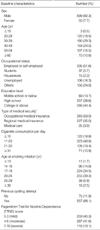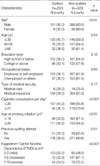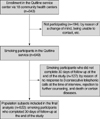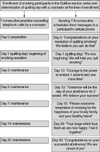INTRODUCTION
Of the various smoking cessation strategies, Quitline services have been reported to be effective in many previous studies (
1-
4). In general, the term "Quitline" service refers to a telephone-based service providing treatment for dependence on or withdrawal symptoms from mostly nicotine and alcohol. Quitline provides easily accessible and convenient counseling services for smoking cessation to those who require help and may supplement face-to-face support or be an adjunct for self-help interventions or pharmacotherapy. This service uses 2 approaches (
5). One is a "reactive" approach where users obtain information or assistance by telephoning Quitline, and the other is a "proactive" approach where a trained counselor telephones the smokers to provide support in initiating a quit attempt and maintaining prolonged abstinence (
5,
6).
The effectiveness of proactive telephone counseling, in particular, has been reported in many studies. According to a recent meta-analysis of the effectiveness of proactive telephone counseling for smoking cessation, the unweighted mean quit rate of the proactive counseling group was 19% (range, 7-33%), and the unweighted mean odds ratio (OR) was 1.64 compared with the control group (
6).
Countries where these national or state Quitlines are known to be operated include the United States, Australia, New Zealand, Sweden, the United Kingdom (
5). However, to the best of our knowledge, no report from the East regarding those Quitline services has been published except the one from Hong Kong (
9).
Moreover, information on the predictors of successful smoking cessation among the Quitline users is lacking. Only a few studies have reported the predictors of successful smoking cessation among users of the Quitline service; these predictors are as follows: older age, low cigarette consumption per day, higher education level, and smoking initiation at later age (
7-
9).
We conducted this study to investigate the effectiveness of the Quitline service and the predictors of successful smoking cessation in Korea.
MATERIALS AND METHODS
Recruitment of smoking participants
From November 1, 2005 to January 31, 2006, smoking participants were voluntarily enrolled in the Quitline service center via 18 community health centers located at 4 megalopolises nationwide. At the time of enrollment, the sociodemographic characteristics and other smoking-related behaviors were recorded. All procedures were conducted after obtaining the participants' verbal consent. An approval procedure of this study from the institutional review board of the National Cancer Center was not done because this preliminary project was initially implemented as a smoking cessation policy of the government.
Fig. 1 shows a flowchart for selection of the population subjects included in the final analysis. In order to estimate the continuous abstinence rate at 30 days of follow-up, we included 522 of the 649 participants in the final analysis, and 127 were excluded because they were designated as "in progress" in the program, that is, they did not complete 30 days of follow-up at the end of the study.
A 30-day smoking cessation program for the proactive Quitline service
Fig. 2 shows a 30-day smoking cessation program for the proactive Quitline service newly developed for this project; this consists of 7 consecutive scheduled counseling sessions conducted on day 0 (the day before the appointed quitting day), day 1 (the quitting day), day 3, day 5, day 7, day 14, and day 30. When the scheduled day for this counseling service was a holiday, a participant received a counseling service on the available day, before or after the scheduled day.
This project used the short message service via cellular phones after the participants' enrollment. The participants themselves decided the counseling days at their convenience. All the counseling sessions were conducted in a one-on-one manner over the telephone by 10 trained smoking cessation counselors who had completed a special training program for smoking cessation counseling at Quitline after studying psychology, clinical psychology, the science of public health, or the science of nursing at the university. The Quitline services operated from 9 a.m. to 6 p.m. during weekdays and were closed on Saturdays, Sundays, and holidays.
Short message services were sent via cellular phones to encourage and support the participants' abstinence as part of the program; this involved sending 7-9 consecutive scheduled short messages in the following order. "Congratulations on your resolution of quitting smoking! We believe you can do that", on day 0; "It's now beginning! We will help you quit smoking", on day 1; "Courage is the power to endure 1 sec and one more time", on day 10; "Tomorrow will be the day of your abstinence for 2 weeks. We believe your success", on day 13; "Please overcome temptation of smoking for the happiness of your lovely family and your healthy future", on day 19; "Your lungs which love fresh air are now happy. Feel it together", on day 24; and "Congratulations on your successful abstinence! We are proud of you", on day 30.
Baseline data collection
Baseline data were collected, including sociodemographic characteristics (sex, age, occupational status, education level, and type of medical security) and smoking-related characteristics (cigarette consumption per day, age at smoking initiation, previous quitting attempts, and Fagerstrom Test for Nicotine Dependence [FTND] score) at the time of the first interview by a smoking cessation counselor.
Outcome measures
The main outcome measure was the self-reported continuous abstinence rate at 30 days of follow-up. In our study, abstinence at a follow-up interview on day 30 refers to continuous abstinence because the participants were considered to be abstinent only if they reported not having smoked since the preceding counseling session, and only those who were abstinent received the next counseling session. We calculated the continuous abstinence rate based on self-reports because biochemical validation is considered uninformative in low-intensity intervention studies such as those on this Quiline service (
10,
11). In the intention-to-treat analysis, "abstinence failure" included both "failure to maintain abstinence" (smoking between days 1 and 30 or refusal to participate in the program further) and "loss to follow-up" (no-response to 3 telephonic calls, refusal to participate in the program on day 0, and inability to participate in the program due to certain diseases or death). Participants who did not complete 30 days of follow-up at the end of the study were considered to be "in progress" and were excluded while calculating the abstinence rate.
Statistical analyses
We estimated the self-reported continuous abstinence rate after 30 days of follow-up based on both a per-protocol analysis and an intention-to-treat analysis. In the per-protocol analysis, those lost to follow-up who could not be contactable, could not continue the protocol due to a certain disease or death, or rejected their participation on day 0, were excluded from the denominator in calculating an abstinence rate. In the intention-to-treat analysis, those lost to follow-up were considered to be in "abstinence failure" and included in the denominator in calculating an abstinence rate.
We used Pearson's chi-square test to identify the predictors of successful abstinence in a univariate analysis. Stepwise multiple logistic regression analysis was performed to assess the predictors of abstinence with adjustments for confounding variables and to estimate ORs and 95% confidence intervals (CIs). All the statistical tests were 2-sided, and p<0.05 was considered to be statistically significant. We used the Statistical Package for the Social Sciences (SPSS) 12.0 K software for Windows for data analyses.
DISCUSSION
We conducted the preliminary project of Quitline for smoking cessation in Korea, which, to our knowledge, is the second Quitline service operating in the East following the first one in Hong Kong.
The intention-to-treat analysis performed in our study showed that 38.3% of the participants of the Quitline service were successfully abstinent at 30 days of follow-up. There have been few studies on the Quitline service that have reported abstinence rates at 30 days of follow-up. Zhu et al. (
3) reported that among participants receiving an average of 3.0 telephone counseling sessions, 23.7% were abstinent at 1 month. Lipkus et al. (
12) found that 19.2% participants receiving 2 tailored telephone sessions from health care providers prompting intervention and tailored print communications were abstinent at 1 month. Miller et al. (
13) suggested that point prevalence abstinence at 3 weeks of follow-up was 19% in the Quitline service; however, this period did not equal 30 days of follow-up.
The abstinence rate in our study was slightly higher than those in the previous 2 studies. This finding is mainly associated with the fact that our telephone counseling protocol consisted of more proactive counseling sessions (7 consecutive sessions) than in the previous studies. According to a recent meta-analysis (
5) of the effectiveness of telephone counseling for smoking cessation published in
The Cochrane Library, 7 trials providing 1 or 2 calls showed no significant effect. In contrast, 19 trials offering between 3 and 6 sessions showed a significant effect (OR, 1.23; 95% CI, 1.23-1.55). Moreover, proactive counseling has been considered to be more effective in encouraging participants to quit smoking than reactive counseling, as shown previously (
5,
6). Therefore, we suggest that the more proactive counseling calls the Quiline service provides, the more effective the service can be because these frequent proactive counseling might not only encourage smoking participants to quit smoking but also motivate them to maintain abstinence. Nevertheless, further analyses regarding this topic will be required in the future.
In addition, the short message service using cellular phones might have contributed to the participants' successful smoking cessation; 7-9 consecutive scheduled short messages were sent in order to encourage and support their abstinence. This short message service using cellular phones as a part of the Quitline service protocol is very unique and can be effective in countries in which Quitline services operate, including Korea, where cellular phones are commonly used. In Korea, there are 83.8 cellular mobile subscribers per 100 inhabitants according to the Information and Communication Technology Statistics 2006 of the International Telecommunication Union (
14).
Another possible explanation for the higher smoking cessation rate is thought to be associated with the smokers' New Year's resolutions to quit smoking; a New Year was included in our study periods.
Furthermore, even though our criteria for abstinence were more rigorous than those in previous studies, the abstinence rate in our study was higher than those in previous studies. In our protocol, participants could progress to the next counseling session of a total of 7 sessions only if they were abstinent during the previous session. This implies that the abstinence rate at 30 days of follow-up in our study was the continuous abstinence rate over 7 consecutive sessions.
Our study measured the current smoking status without using biochemical validation techniques such as urinary cotinine concentration or expired carbon monoxide commonly used in smoking cessation-related researches because biochemicalvalidation is considered to be uninformative in low-intensity interventions such as those in the Quitline service (
3,
10,
11). Moreover, several previous studies have suggested that self-reported smoking status is considerably accurate (
15,
16).
The univariate analysis helped in determining 4 predictors of successful smoking cessation, namely, sex, age at smoking initiation, cigarette consumption per day, and the severity of nicotine dependence, which were consistent with those determined in previous studies. Further, previous studies have indicated that the predictors of smoking cessation were as follows: age, sex, cigarette consumption per day, readiness to quit smoking, follow-up time, education level, perceived ease or difficulty in quitting, presence of smokers at home, helpful support during quitting, previous history of abstinence, use of clinical help and/or nicotine replacement therapy (
6-
9). No differences were noted in the predictors of smoking cessation between the results of the univariate and the multiple logistic regression analyses because we excluded the variable FTND score in the final analysis in order to avoid multicollinearity with the cigarette consumption per day. The final predictors of successful smoking cessation were male sex; smoking 20 or less cigarettes per day; age, 20 yr or more at smoking initiation, in the stepwise multiple logistic regression analysis adjusted for possible independent variables.
Nonetheless, there are several limitations of this study. First, the effectiveness of this preliminary Quitline service is limited to the short term. A long-term study will be required because the effectiveness of the interventions for smoking cessation tends to decrease as the follow-up time increases. Second, of a total of 522 participants, 23.2% were lost to follow-up. Most of them were those who did not respond to 3 consecutive telephonic calls at the time of a counseling session. Non-responders were considered to have resumed smoking; however, further evaluation of the reason for not responding is required. Third, the proportion of female participants was extremely low. However, this can be explained by sex differences in the smoking prevalence in Korea. According to the reports of the Korean Association of Smoking and Health conducted in December 2006, the smoking prevalence was 44.1% among Korean men, but only 2.3% among Korean women. Fourth, we did not explore other possible motivations and various social supports as factors for successful smoking cessation. Fifth, our study had no control group. Finally, our study had a potential selection bias due to the enrollment from community health centers, not from the general population. Furthermore, 194 of 843 enrollees did not participate in this Quitline service by reasons of mind change, being unable to contact, etc. It might be another explanation associated with a possible selection bias that attitudes toward the study protocol and Quitline service were different for those 194 persons. Further studies with a control group would be needed in order to investigate the evident effectiveness of the Quitline service.
In conclusion, we investigated the short-term effectiveness of the Quitline service and determined the predictors of successful smoking cessation. Further studies with longer follow-up periods should be conducted to determine the effectiveness and usefulness of the Quitline service.







 PDF
PDF ePub
ePub Citation
Citation Print
Print






 XML Download
XML Download